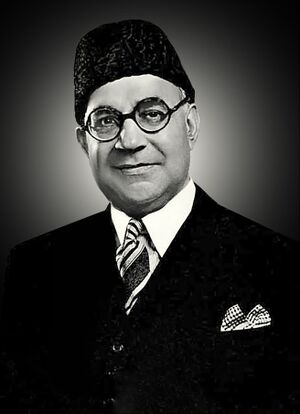Liaquat Ali Khan
(politician) | |
|---|---|
 | |
| Born | 1895-10-01 Karnal, Punjab, India |
| Died | 1951-10-16 (Age 56) Rawalpindi, Punjab, Pakistan |
| Alma mater | Aligarh Muslim University, Exeter College (Oxford), Inns of Court School of Law |
| Victim of | assassination |
| Party | Muslim League |
Pakistan's first and longest serving Prime Minister, murdered Afghan nationalist, or according to some theories, by the USA in order to facilitate their access to oil.
| |
Liaquat Ali Khan , widely known as Quaid-e-Millat (Leader of the Nation) and Shaheed-e-Millat (Martyr of the Nation), was a Pakistani statesman, lawyer, political theorist, and one of the leading founding fathers of Pakistan. He became the first Prime Minister of Pakistan; he also held cabinet portfolio as the first foreign, defence, and the frontier regions minister from 1947 until his assassination in 1951. Prior to the partition, Khan briefly tenured as the first finance minister in the interim government led by its Governor General Mountbatten.
Assassination
On 16 October 1951, Khan was shot twice in the chest while he was addressing a gathering of 100,000 at Company Bagh (Company Gardens), Rawalpindi.[1][2] The police immediately shot the presumed murderer who was later identified as professional assassin Said Akbar.[2] Khan was rushed to a hospital and given a blood transfusion, but he succumbed to his injuries.
Said Akbar Babrak was an Afghan national from the Pashtun Zadran tribe.[3] The exact motive behind the assassination has never been fully revealed and much speculation surrounds it,[4] but seem to lean towards the theory that Babrak was a Pashtun ultra-nationalist who hoped Khan’s death would pave the way to a united Pakhtunistan in the border areas between Afghanistan and Pakistan.
However there are many conspiracy theories claiming that Liaquat Ali Khan’s assassination was planned by foreign powers. Some say it was a reaction from the USSR for his anti-communist and pro-western policies, while others blame the USA for ordering the killing due to Khan’s alleged non-cooperation on the Iranian issue and an alleged demand for the US to vacate its airbases in Pakistan.[5]
The place where it happened is the same location where ex-Prime Minister Benazir Bhutto was assassinated in 2007.[6]
Pressure by US
Pakistani newspaper articles have stated that "declassified documents"[Which?][Where?] reveal that the United States wanted to control the oil resources in Iran. Pakistan and Iran enjoyed cordial ties and Afghanistan used to be an enemy of Pakistan during 1950-51. The US told Pakistan to use its influence in Tehran and persuade it to transfer control of its oil fields to the US, but Liaquat Ali Khan refused, stating that he would not use his friendship for dishonest purposes. US President Harry Truman was outaged by this and threatened Liaquat Ali Khan with assassination.[7][dead link][better citation needed] The "declassified documents" seem to be US embassy cables summarizing a press article published in the Urdu daily of Bhopal, “Nadeem” on Oct. 24, 1951, charging the US with the responsibility of Khan’s death. [8]
References
- ↑ https://tribune.com.pk/story/93713/unexplained-assassinations/
- ↑ a b https://www.dawn.com/news/281990%7Ctitle=Liaquat Bagh adds to its gory history
- ↑ http://www.dailytimes.com.pk/default.asp?page=story_28-9-2004_pg7_47
- ↑ hhttps://web.archive.org/web/20090707233740/http://www.gulfnews.com/opinion/columns/world/10329078.html
- ↑ https://tribune.com.pk/story/93713/unexplained-assassinations
- ↑ http://in.reuters.com/article/topNews/idINIndia-31172420071230
- ↑ http://www.pakistantoday.com.pk/2015/04/17/national/secret-is-out-americans-murdered-liaquat-ali-khan/
- ↑ https://www.arabnews.com/node/287940